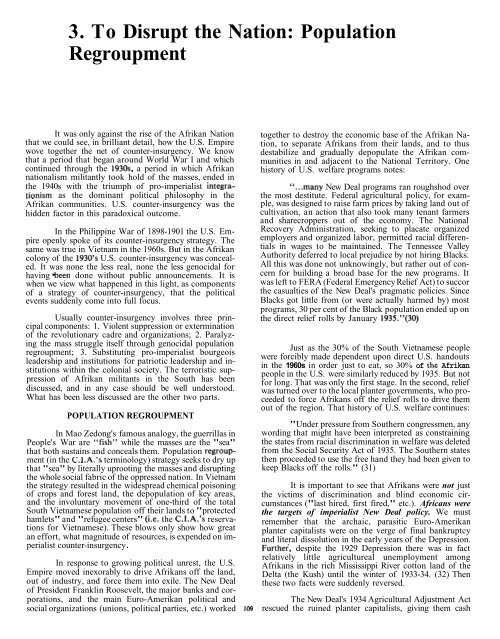sakaisettlersocr
sakaisettlersocr
sakaisettlersocr
You also want an ePaper? Increase the reach of your titles
YUMPU automatically turns print PDFs into web optimized ePapers that Google loves.
3. To Disrupt the Nation: Population<br />
Regroupment<br />
It was only against the rise of the Afrikan Nation<br />
that we could see, in brilliant detail, how the U.S. Empire<br />
wove together the net of counter-insurgency. We know<br />
that a period that began around World War I and which<br />
continued through the 1930s, a period in which Afrikan<br />
nationalism militantly took hold of the masses, ended in<br />
the 1940s with the triumph of pro-imperialist integrationism<br />
as the dominant political philosophy in the<br />
Afrikan communities. U.S. counter-insurgency was the<br />
hidden factor in this paradoxical outcome.<br />
In the Philippine War of 1898-1901 the U.S. Empire<br />
openly spoke of its counter-insurgency strategy. The<br />
same was true in Vietnam in the 1960s. But in the Afrikan<br />
colony of the 1930's U.S. counter-insurgency was concealed.<br />
It was none the less real, none the less genocidal for<br />
having -been done without public announcements. It is<br />
when we view what happened in this light, as components<br />
of a strategy of counter-insurgency, that the political<br />
events suddenly come into full focus.<br />
Usually counter-insurgency involves three principal<br />
components: 1. Violent suppression or extermination<br />
of the revolutionary cadre and organizations; 2. Paralyzing<br />
the mass struggle itself through genocidal population<br />
regroupment; 3. Substituting pro-imperialist bourgeois<br />
leadership and institutions for patriotic leadership and institutions<br />
within the colonial society. The terroristic suppression<br />
of Afrikan militants in the South has been<br />
discussed, and in any case should be well understood.<br />
What has been less discussed are the other two parts.<br />
POPULATION REGROUPMENT<br />
In Mao Zedong's famous analogy, the guerrillas in<br />
People's War are "fish" while the masses are the "sea"<br />
that both sustains and conceals them. Population regroupment<br />
(in the C.I.A.'s terminology) strategy seeks to dry up<br />
that "sea" by literally uprooting the masses and disrupting<br />
the whole social fabric of the oppressed nation. In Vietnam<br />
the strategy resulted in the widespread chemical poisoning<br />
of crops and forest land, the depopulation of key areas,<br />
and the involuntary movement of one-third of the total<br />
South Vietnamese population off their lands to "protected<br />
hamlets" and "refugee centers" (i.e. the C.I.A.'s reservations<br />
for Vietnamese). These blows only show how great<br />
an effort, what magnitude of resources, is expended on imperialist<br />
counter-insurgency .<br />
In response to growing political unrest, the U.S.<br />
Empire moved inexorably to drive Afrikans off the land,<br />
out of industry, and force them into exile. The New Deal<br />
of President Franklin Roosevelt, the major banks and corporations,<br />
and the main Euro-Amerikan political and<br />
social organizations (unions, political parties, etc.) worked<br />
together to destroy the economic base of the Afrikan Nation,<br />
to separate Afrikans from their lands, and to thus<br />
destabilize and gradually depopulate the Afrikan communities<br />
in and adjacent to the National Territory. One<br />
history of U.S. welfare programs notes:<br />
"...many New Deal programs ran roughshod over<br />
the most destitute. Federal agricultural policy, for example,<br />
was designed to raise farm prices by taking land out of<br />
cultivation, an action that also took many tenant farmers<br />
and sharecroppers out of the economy. The National<br />
Recovery Administration, seeking to placate organized<br />
employers and organized labor, permitted racial differentials<br />
in wages to be maintained. The Tennessee Valley<br />
Authority deferred to local prejudice by not hiring Blacks.<br />
All this was done not unknowingly, but rather out of concern<br />
for building a broad base for the new programs. It<br />
was left to FERA (Federal Emergency Relief Act) to succor<br />
the casualties of the New Deal's pragmatic policies. Since<br />
Blacks got little from (or were actually harmed by) most<br />
programs, 30 per cent of the Black population ended up on<br />
the direct relief rolls by January 1935."(30)<br />
Just as the 30% of the South Vietnamese people<br />
were forcibly made dependent upon direct U.S. handouts<br />
in the 1960s in order just to eat, so 30% of thc Afrikan<br />
people in the U.S. were similarly reduced by 1935. But not<br />
for long. That was only the first stage. In the second, relief<br />
was turned over to the local planter governments, who proceeded<br />
to force Afrikans off the relief rolls to drive them<br />
out of the region. That history of U.S. welfare continues:<br />
"Under pressure from Southern congressmen, any<br />
wording that might have been interpreted as constraining<br />
the states from racial discrimination in welfare was deleted<br />
from the Social Security Act of 1935. The Southern states<br />
then proceeded to use the free hand they had been given to<br />
keep Blacks off the rolls." (31)<br />
It is important to see that Afrikans were not just<br />
the victims of discrimination and blind economic circumstances<br />
("last hired, first fired," etc.). Africans were<br />
the targets of imperialist New Deal policy. We must<br />
remember that the archaic, parasitic Euro-Amerikan<br />
planter capitalists were on the verge of final bankruptcy<br />
and literal dissolution in the early years of the Depression.<br />
Furthei, despite the 1929 Depression there was in fact<br />
relatively little agricultureal unemployment among<br />
Afrikans in the rich Mississippi River cotton land of the<br />
Delta (the Kush) until the winter of 1933-34. (32) Then<br />
these two facts were suddenly reversed.<br />
The New Deal's 1934 Agricultural Adjustment Act<br />
109 rescued the ruined planter capitalists, giving them cash


